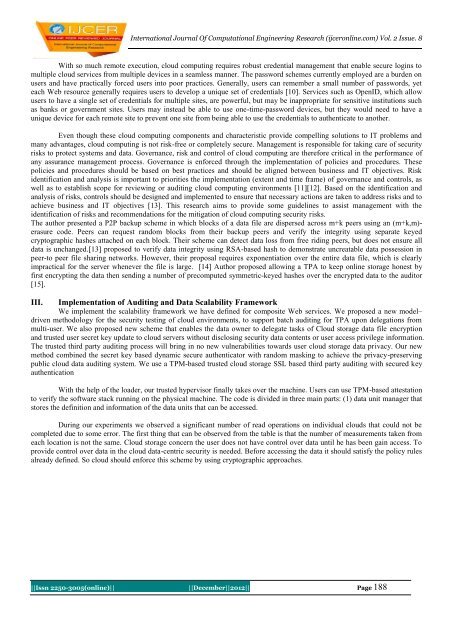ISSN: 2250-3005 - ijcer
ISSN: 2250-3005 - ijcer
ISSN: 2250-3005 - ijcer
You also want an ePaper? Increase the reach of your titles
YUMPU automatically turns print PDFs into web optimized ePapers that Google loves.
International Journal Of Computational Engineering Research (<strong>ijcer</strong>online.com) Vol. 2 Issue. 8With so much remote execution, cloud computing requires robust credential management that enable secure logins tomultiple cloud services from multiple devices in a seamless manner. The password schemes currently employed are a burden onusers and have practically forced users into poor practices. Generally, users can remember a small number of passwords, yeteach Web resource generally requires users to develop a unique set of credentials [10]. Services such as OpenID, which allowusers to have a single set of credentials for multiple sites, are powerful, but may be inappropriate for sensitive institutions suchas banks or government sites. Users may instead be able to use one-time-password devices, but they would need to have aunique device for each remote site to prevent one site from being able to use the credentials to authenticate to another.Even though these cloud computing components and characteristic provide compelling solutions to IT problems andmany advantages, cloud computing is not risk-free or completely secure. Management is responsible for taking care of securityrisks to protect systems and data. Governance, risk and control of cloud computing are therefore critical in the performance ofany assurance management process. Governance is enforced through the implementation of policies and procedures. Thesepolicies and procedures should be based on best practices and should be aligned between business and IT objectives. Riskidentification and analysis is important to priorities the implementation (extent and time frame) of governance and controls, aswell as to establish scope for reviewing or auditing cloud computing environments [11][12]. Based on the identification andanalysis of risks, controls should be designed and implemented to ensure that necessary actions are taken to address risks and toachieve business and IT objectives [13]. This research aims to provide some guidelines to assist management with theidentification of risks and recommendations for the mitigation of cloud computing security risks.The author presented a P2P backup scheme in which blocks of a data file are dispersed across m+k peers using an (m+k,m)-erasure code. Peers can request random blocks from their backup peers and verify the integrity using separate keyedcryptographic hashes attached on each block. Their scheme can detect data loss from free riding peers, but does not ensure alldata is unchanged.[13] proposed to verify data integrity using RSA-based hash to demonstrate uncreatable data possession inpeer-to peer file sharing networks. However, their proposal requires exponentiation over the entire data file, which is clearlyimpractical for the server whenever the file is large. [14] Author proposed allowing a TPA to keep online storage honest byfirst encrypting the data then sending a number of precomputed symmetric-keyed hashes over the encrypted data to the auditor[15].III. Implementation of Auditing and Data Scalability FrameworkWe implement the scalability framework we have defined for composite Web services. We proposed a new model–driven methodology for the security testing of cloud environments, to support batch auditing for TPA upon delegations frommulti-user. We also proposed new scheme that enables the data owner to delegate tasks of Cloud storage data file encryptionand trusted user secret key update to cloud servers without disclosing security data contents or user access privilege information.The trusted third party auditing process will bring in no new vulnerabilities towards user cloud storage data privacy. Our newmethod combined the secret key based dynamic secure authenticator with random masking to achieve the privacy-preservingpublic cloud data auditing system. We use a TPM-based trusted cloud storage SSL based third party auditing with secured keyauthenticationWith the help of the loader, our trusted hypervisor finally takes over the machine. Users can use TPM-based attestationto verify the software stack running on the physical machine. The code is divided in three main parts: (1) data unit manager thatstores the definition and information of the data units that can be accessed.During our experiments we observed a significant number of read operations on individual clouds that could not becompleted due to some error. The first thing that can be observed from the table is that the number of measurements taken fromeach location is not the same. Cloud storage concern the user does not have control over data until he has been gain access. Toprovide control over data in the cloud data-centric security is needed. Before accessing the data it should satisfy the policy rulesalready defined. So cloud should enforce this scheme by using cryptographic approaches.||Issn <strong>2250</strong>-<strong>3005</strong>(online)|| ||December||2012|| Page 188
















